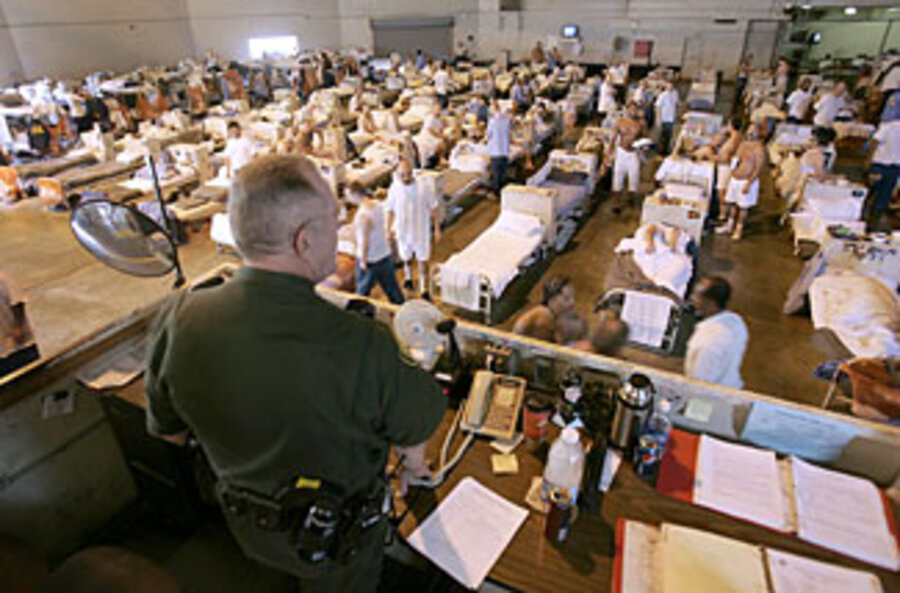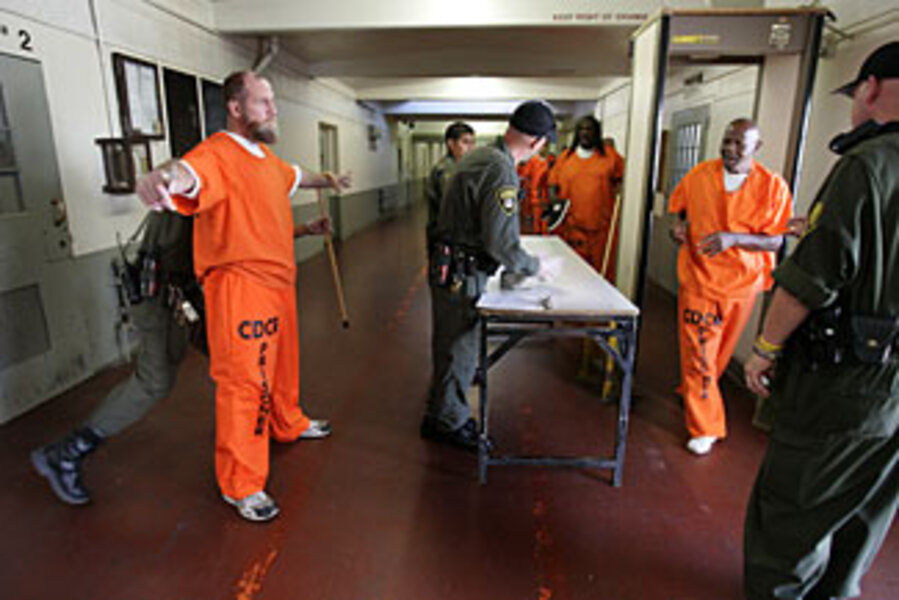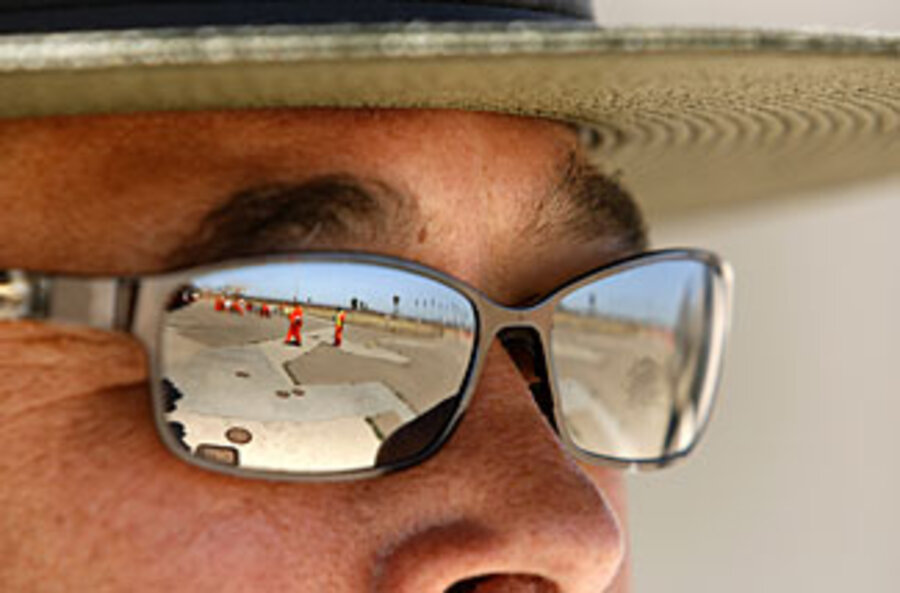Parole holds key to California prison overcrowding
Loading...
| tracy, calif.
Standing in a dim prison gymnasium that's been converted into a vast cell to house 300 inmates, Phillip Nelson talks about how he's spent much of his adult life incarcerated. He's been in and out of the Deuel Vocational Institution, a 1950s-era penitentiary that is now California's most overcrowded prison, partly due to parole violations since being convicted of receiving stolen property in the 1980s.
"I wouldn't be in prison if it weren't for the parole system," says Mr. Nelson, who was most recently sent back to prison for violating the terms of his parole because, he claims, he missed a "class."
Many of his fellow inmates, who sleep in cots lined up in rows stretching the width of the gym, also say they returned to prison for parole violations.
That is set to change. California has made sweeping changes to its parole system that experts and government officials say are key to reducing dangerously high populations in the nation's largest correctional system.
"Until we get parole under control, we can't get prison crowding under control," says Joan Petersilia, a law professor at Stanford University who has written extensively on California's parole system.
Between 60,000 and 70,000 California parolees return to custody annually for violations. They may have failed a drug test, gone missing, or even committed a new crime for which they were not prosecuted. They're sent back to a system that is so overcrowded and underserved that a federal judicial panel, describing conditions as "woefully and constitutionally inadequate," in August ordered the state to reduce its 170,000 prison population – double its capacity – by 40,000 inmates.
It was partly in response to that order that California lawmakers passed a prison reform bill this month.
Efforts to change the state's parole system have met fierce resistance for years from tough-on-crime advocates, says Ms. Petersilia. This time, too, concerns about relaxing parole rules were raised after the arrest of Phillip Garrido, a convicted sex offender and parolee, for the abduction of Jaycee Lee Dugard.
But the state now faces a perfect storm of problems surrounding its system of incarceration: a federal lawsuit, a fiscal crisis crippling its economy, and public opinion that has slowly been shifting away from rigid sentencing laws.
And in August, just four days after the judicial order, 55 inmates were injured and a dormitory burned down in a prison riot in Chino that Gov. Arnold Schwarzenegger blamed on overcrowding.
No parole for low-risk criminals
Following the passage of the prison reform bill Sept. 11, state prison officials submitted a more ambitious plan to reduce overcrowding to the federal judicial panel. Even this doesn't go as far as the court wanted in cutting inmates – just 18,000 over two years versus 40,000.
But the prison bill does introduce parole reforms that have been long called for.
The crux of these reforms lies in reserving active parole supervision for only the most violent offenders. Instead of a system in which even the least violent offenders are put under some sort of supervision, low-risk criminals will now be placed on "banked parole," which means they can still be subject to warrantless searches by police but are not under regular supervision.
Also, parolees will be less likely to be sent back to prison if they commit a "technical" violation, such as failing a drug test. Instead, many will be sent to community-based programs.
This will mean many fewer people cycling through California's prisons. That will reduce prison populations and almost halve the caseload for each parole officer, with the intent that officers can spend more time supervising the most dangerous prisoners.
"The centerpiece of this legislation is the parole reform that protects public safety," says Rachel Cameron, a Schwarzenegger spokeswoman.
Busting state budgets
California's reforms mirror other states' moves to rethink a tough-on-crime attitude first adopted by politicians – and demanded by the public – in the 1970s, attitudes that extended through the drug war of the 1990s.
The recession has highlighted the burden of overcrowded prisons nationwide. As budgets shrink, prison spending continues to swell as inmate populations grow. California spent about $10 billion to house roughly 170,000 inmates in 2008 – a 32 percent increase in spending since 2005.
States such as South Carolina, Kentucky, and Illinois have set up sentencing commissions in the past few years to rethink tough sentencing laws that many say are at the root of overcrowding. (In California, those laws indirectly led to the adoption of universal parole supervision.)
Life-term sentences, for instance, quadrupled over the past 24 years, according to the Sentencing Project, a Washington group that advocates for prison reforms. That's largely due to "three strikes" laws that mandate 25 years to life for third-time felony offenders.
The fact that California's reforms don't include a sentencing commission suggests to some that state politicians are still hesitant to seem soft on crime. The prison bill originally held proposals for such a commission, as well as provisions to allow some offenders to serve the last year of their sentence under house arrest, but they were removed in an effort to win over Republicans, who said it went too easy on criminals.
Parole reforms are still opposed by the California Correctional Peace Officers Association, a powerful force in state politics. "If hardened criminals are released early – without supervision or support – crime will increase and lives will be lost," said the association's acting president, Chuck Alexander, in a statement.
Dingy, crowded cells
Whether parole reform alone can fix the problem of prison overcrowding is unclear; what's not is that it desperately needs fixing.
At the Deuel prison in Tracy, 3,900 inmates crowd into a facility designed for 1,700. It's a vocational institute in name only. Gilbert Valenzuela, the public information officer, says that when he arrived 20 years ago, Deuel had a vocational shop where inmates could learn a trade. "[That] would have really benefited the inmates a lot and also the community," he says.
Chief Deputy Warden Ron Rackley acknowledges crowding has taken a toll on infrastructure and on staff and prisoners. In his airy office, seemingly a world away from the dingy cells, he says, "When you are sleeping with your head at the foot of another man, you tend to be irritable."
Jenaro Torres, a tattooed inmate with thick braids, is blunter: "At least in a cell you only have to deal with the other person," he says. "This isn't even made for living."•







